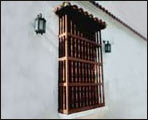San Salvador de Bayamo is the second of the seven villages founded by Diego Velázquez. The area, where an indigenous community once settled down next to the shores of a river was finally established on November 5 th,1513.
By the end of 1514 , the unhappy colonizers with the houses already taken on their own moved their church to the indigenous town where the gift of its fertile soils as well as the high number of immigrants coming from Baracoa made easier a quick growth of the population. , the unhappy colonizers with the houses already taken on their own moved their church to the indigenous town where the gift of its fertile soils as well as the high number of immigrants coming from Baracoa made easier a quick growth of the population.
This village is admired for having been the capital of the First Republic in Arms during the nineteenth - century struggle for independence. It is related to its inhabitants’ decision of setting their own town on fire rather than see it fall intact into the colonizers’ hands. Homeland of Carlos Manuel de Céspedes, known as the Padre de la Patria. It was also the place where the national anthem was finally conformed together with the waves of the struggle. The one that accompanied the Cubans to the warlike conflict and it still exits. The huge historical background that accompanied the visitors goes together with the exponents of the colonial architecture reflected in its constructions and museums that still stand erected in spite of the years.
Bayamo was, according to the legend, a name given by the aboriginals to the tree of wisdom (Bayam) which transformed into tame lambs even the wild beasts that kept under its shadow. In this way, its origin goes back to the birth of their own cultures that they knew how to defend before the arrival of strangers.
Rebels were its first townspeople even without having any experience for the war. Rebel, it has been throughout its history in order to stand itself as a steady trunk of that legendary tree.
|